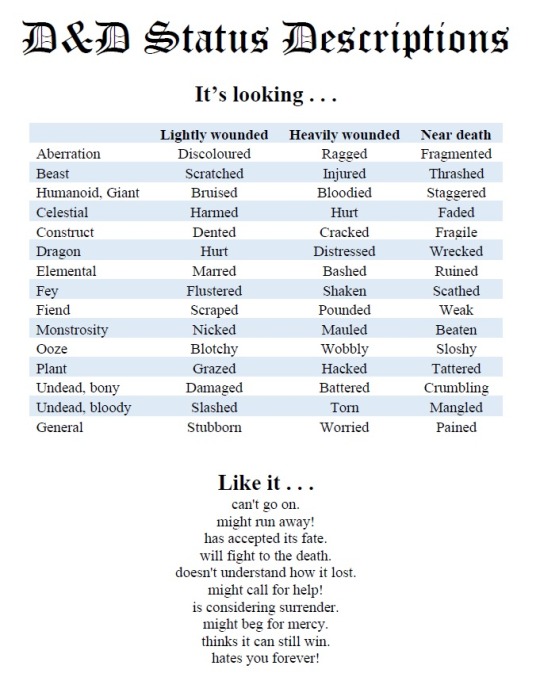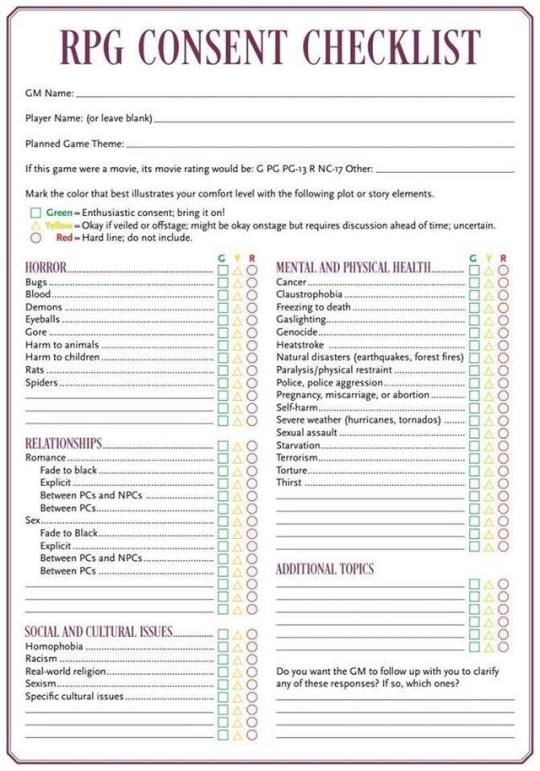Just a not-so-epic pathfinder campaign Header from yuchenghong on DeviantArt Youtube: https://www.youtube.com/channel/UCPZh6uYJKffuwQ7ZSj6C5sg
Don't wanna be here? Send us removal request.
Text
Oh fuck actual RPG enemy idea.
Show something is an eldritch being by having it only be fluff. That is, it’s got a appearance and stuff, but it doesn’t really exist in the way normal beings do. It’s not part of the rules of the world. It’s got no stats, it’s just an empty thing that can’t interact with our world. So it tries to lure you. Things seen in the forest, or down alleys. Strange noises in the night. So you roll knowledge or tracking or so forth. And you, a real being, have given it reality. And so it starts to get crunch. You roll enough to see its prints have claws, and now it has a claw attack. You note that whatever it seems to be moving quickly, and now it has an AC. Reports show it acting deliberately, and it has a INT score. You encounter it, and it’s a vague hollow shadow, but every time you try and investigate it it gets visibly more real. You peer at it to see what its skin looks like and boom, it goes from a vauge figure to having actual skin and DR to go with it. Eventuality, you hopefully figure out whats going on before it gets a full stat block. You need to make sure it has HP and AC and so forth so you can kill it, but you need to do so without investigating it too much so you don’t give it spell-like abilities. I like the idea of representing the eldritch through stats- an eldritch abomination is a being that breaks the rules of the world, and an rpg, more then any other medium, has rules to break. What do people think? -Mod Pencil
3K notes
·
View notes
Text
More favourite tabletop RPG rules:
Beautiful Anomalies uses card-based conflict resolution. When a player uses a card, it’s played face-up into a special discard pile called the Timeline. The GM draws cards for their own hand from the Timeline, starting with the oldest cards and working inward; thus, if you use a powerful card, you can literally watch it creep across the table until the GM can draw it and use it against you.
In Blades in the Dark, one of the crew playbooks (basically a party-level character sheet that grants special abilities to everyone in the group) has a trait that’s literally just “you know how to sell drugs to ghosts”. It explicitly states that the ghosts don’t pay for their drugs with money, but leaves it up to the players to decide what they do pay in.
In Double or Nothing, there’s a special token that gives you a bonus to all of your actions. Only one player can have it at a time, and you can steal it by having your character flirt with their character. Every time someone steals it back, they have to escalate – but if it actually gets to the point of making out, the token is removed from play entirely, because now you’ve made it weird. If this happens two sessions in a row, the next adventure is required to take place during the characters’ wedding.
In Fellowship, each player in the titular Fellowship – yes, it’s very Lord of the Rings – takes on the role of an exemplar of their people, and your character creation decisions literally define what your people are like. For example, if you’re playing The Elf, you can totally decide that your elf is a mermaid, and now that’s what elves are like in this campaign. The GM just has to roll with it!
In Feng Shui 2nd Edition, if you’re wielding a shotgun you can get a bonus to damage by miming the action of racking the slide and making a KA-CHUNK noise with your mouth before rolling for your attack.
Michtim is a game about tiny hamster-like creatures having whimsical adventures, with dice mechanics based on your emotional state. Basic character types include artists, chefs, musicians, etc., and also for some reason cyborg warriors with optical camouflage and wired reflexes and such. Even more strangely, any character can freely multiclass as a cyborg, which raises some frankly fascinating worldbuilding questions.
In Mythender, your character is such an unbelievable badass that it’s literally impossible for you to fail at any task. You only roll dice a. to look cool doing it (this is easy), and b. to avoid causing hideous collateral damage and shattering the minds of mortal witnesses in the process (this is very difficult).
In Ocean, a game about being trapped in an undersea research station, some things that are usually the GM’s responsibility are distributed based on the relationships between the player characters. In particular, you must decide which character your character trusts the least, and that character’s player gets to narrate the results of your failed rolls.
Tenra Bansho Zero, a localised Japanese RPG that’s basically every anime series at once, has an inverted death spiral. Your character only takes wounds if you voluntarily choose for them to (otherwise they just get knocked out and have to sit the rest of the scene out), and more serious wound levels confer escalating bonuses to physical actions. The most severe wound level is “Dead”, which grants three extra dice.
Every character in Wisher, Theurgist, Fatalist has a stat that governs how well they understand the deep laws of the cosmos. This includes the actual game mechanics, meaning players can roll this stat to make up new rules on the spot, or even overrule the GM’s interpretation of existing rules. If you win enough of these rolls, you become the GM – whether you want to be or not! – while the old GM becomes a player.
5K notes
·
View notes
Text
The party after the DM starts dropping hints on a puzzle bc they’re taking too long to figure it out:

17K notes
·
View notes
Photo

Status Descriptions for when my players ask how the monster looks
21K notes
·
View notes
Text
“well we do sort of have a army” “The chickens do not count”
606 notes
·
View notes
Text
fuck ‘good’, ‘neutral’ and ‘evil’, the only d&d alignments that actually matter are ‘mom’, ‘edgy’ and ‘stupid’
17K notes
·
View notes
Text
Like honestly the biggest piece of tabletop rpg advice I can give other players, as someone whose done a lot of playing and some dm’ing, is to interact with the npcs. Interact with them a lot. Ask them questions, get invested in their stories, tell them about yourself, befriend them, make them your nemeses, flirt with them, trick them, hell, even marry them, just generally behave towards them in them the way that your character, to whom they would be people just as real as themselves, realistically would.
This can really help you make your character memorable. In an average tabletop party, theres only around two to four other player characters. That’s not a lot of people to bounce off of, if you’re treating everyone else as scenery! Opening up to npcs gives you a chance to have your character do and say things they wouldn’t do or say to a party member, allowing you to show depth to your character that would be hard to see otherwise! If you have something specific you’ve been wanting your character to get a chance to reveal and you aren’t finding an outlet to, it can be really helpful to be able to turn to the one player you know has the most mutual investment in seeing your character do something interesting; the dm.
It’s also something that helps make the game more rewarding and worthwhile for the dm! They’re a roleplayer too, and just like you they want an exciting and interesting reason to come to the table each session. They get invested in the characters they’ve made, just as much as anyone, and the more interest you show in that work they’ve put in, the more motivated they are to keep doing it.
587 notes
·
View notes
Photo

This popped up in one of my FB groups and I thought it was rad!
58K notes
·
View notes
Text
My fiancee and I were discussing the worst metal to use to make armor, and the obvious answers are lead and gold, but she cunningly suggested mercury. Which is a fair point, but then I wondered if solid mercury is any good. Googling told me that the melting point of mercury is -38° c (-37° f), so first you get it really fucking cold. At that point, it turns out that mercury has a tensile strength of 1900 mpa, compared to lead’s 18 and steel’s ~500-940 (depending upon the kind of steel).
Now, I know that tensile strength is not necessarily the best measure of a material’s ability to function as armor, but I’m a liberal arts major and didn’t care to actually do that much more research before going straight to, “EVIL ICE DEMONS IN MERCURY ARMOR. THE PCS CAN’T LOOT IT BECAUSE WHEN THEY PUT IT ON IT MELTS AND KILLS THEM.”
74K notes
·
View notes
Note
My current party is attempting to eat anything they find and that includes cannibalism so honestly idk what to do with them
Poison? - Mod Paper
2K notes
·
View notes
Text
Alternative explanations for why your fantasy setting has powerful magic items just lying around where any random schmuck can pick them up:
Up until a couple hundred years ago, the world’s magical background radiation level was much lower than it is today. Most magic items were once minor lucky charms and simple household conveniences; being designed to function in what’s now considered a low-magic environment, their effects have not only increased considerably in power, but have also become warped in unexpected and frequently ironic ways.
It’s impossible to create a magic item on purpose. Random objects just become magical, and nobody really knows why. Living things are never affected, and the phenomenon seems to favour manufactured objects over natural ones, though it’s unknown whether this is a real trend, or a reflection of the fact that people rarely “use” natural objects in ways that are likely to trigger any powers they might possess.
Magic items are the larval form of monsters. They spend the first part of their life cycle sessile, feeding off of the heroic destinies of the adventurers who carry them. When those adventurers eventually TPK, it triggers the next stage of the items’ development; shortly thereafter, the items “hatch” into a new colony of monsters and spawn the next generation of magic items, continuing the cycle.
There exists a possible future where the forces of Order and Chaos fuck up so badly that the world is torn apart and smeared across its own past. The wreckage of that future are/have been/will be raining down over the entire span of history leading up to it. Being indestructible, magic items comprise the bulk of the debris, but sometimes creatures, buildings or chunks of terrain make it through, which is where dungeons come from.
The world’s supply of magic items is actually very limited, but is constantly being manipulated by the gods to place them in the paths of people who will make best use of them – where “best use” is defined roughly as “hey, you know what would be hilarious?”. The random magic item tables the GM rolls on aren’t a game-mechanical conceit, but a completely literal modelling of the gods’ decision-making process.
There are no such thing as magic items. Sometimes ordinary objects just do things when adventurers pick them up. Almost no-one knows this.
19K notes
·
View notes
Text
Being a Player, being a DM
TLDR: My DM style has been influenced a lot by my experiences playing in TTRPGs, and I think there is a lot DMs can learn from being a player
Prior to even thinking about being a DM I had been a player for a number of years. I’d played in games from 3e, 3.5, Pathfinder, and even a weird space Homebrew 5e system. I didn’t really even consider the idea of being a DM until 2017, even though I had helped out other DMs and writers with a variety of things
So when I picked up the mantle as a DM, I already had a huge well of experience on what I liked as a player. So here are just a couple things I do as a DM that I learned from being a player:
I Avoid Prophecy Plots
Or more accurate if I plan to use a prophecy, I make the prophecy about what the villains are doing (rather than the PCs) The problem I found with prophecies is that it can make it feel like the PCs HAVE to do certain things in a certain way and they can’t fail if they do those things. This can end up taking away player agency and/or taking out a feeling of risk because the players know the DM can’t kill them off because that would ruin the entire prophecy
I Don’t Know the Answer
There is a lot of thinking power between 3 or 4 players, and a lot of times if I have a puzzle or encounter the players will come to very different solution than what I expect. For this reason I design a lot of things with the mindset that I am giving the player a problem and reason out a solution to it that they come up with, rather than trying to design something with a set solution and then guiding players towards that.
Rule of Cool
There are a LOT of things I have let my players do simply because they lead to interesting or fun outcomes. As an example, a Wizard player in my home game usually carries the spell Grease because I ruled that the grease it creates is flammable and works like Alchemist Fire or a flask of oil. When players realize they can do things in an unorthodox way, a lot of times that makes for really cool moments for them, and so whenever I can bend the rules in favor of allowing a player to do something cool, I do.
A Tarrasque is Always an Option
This is pretty much my motto as a DM. What I mean by this is that the DM has all the power in the multiverse, and so virtually nothing the players do or are capable of doing is OP relative to the DM. I have 0 problem giving players a shiny new toy or magic item on occasion and letting them feel like their character is becoming super powerful even if that means a little extra work for me in making challenging encounters. Players LOVE getting new items to use, so the logic behind this is pretty similar to the Rule of Cool.
So yeah, those are just a few things I do as a result of my experience as a player.
2K notes
·
View notes
Text
D&D is a wild experience when you’re invested, you’re simultaneously playing a game, creating a narrative, and become a fandom??? so you and your friends can talk for hours about your characters and theories while guarding character secrets to not spoil anything and then think ‘i can’t wait for the next episode’, while knowing you’ll actually be collaboratively generating content, but are still like ‘i cant believe my dumbass child did that’
28K notes
·
View notes
Photo

i made this for my players but i think other d&d games might appreciate it
2K notes
·
View notes


